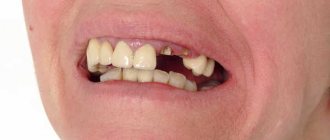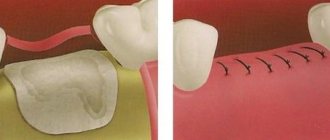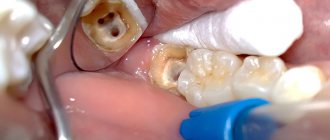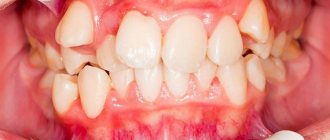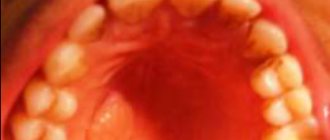Does it hurt to have teeth removed?
Many patients try to put off visiting the dentist until the last minute because of a panicky fear of the doctor’s chair.
They endure painful sensations, rinse their mouths with various decoctions and wonder whether it is painful to remove a tooth - after all, the feeling of possible pain during the procedure can scare away even the most fearless patient. Thus, the situation can be delayed to such an extent that teeth have to be removed urgently. In fact, now in dentistry all conditions are created not only to ensure that the removal goes smoothly, but also to ensure that the patient feels as comfortable as possible. For those who are still afraid of the extraction procedure, it will be very useful to read this article; further, the types of modern anesthetics will be described in detail, how extraction is carried out, and in which cases it is better not to delay a visit to the dentist.
Is it painful to remove a tooth with ultracaine?
Hi all! I haven't been here for a long time... So much has happened in just one week. Therefore, now I will complain about doctors.
On Sunday afternoon (February 16), the gum under the lower wisdom tooth hurt, so that on the right, having suffered all day, in the evening I went to the dental emergency room, where the doctor, who looked more like a butcher, with trembling hands, rolled me ice caine, picked my gum a little and sent me on my way. The pain has subsided a little, but... the tooth had grown incorrectly and needed to be removed a long time ago, although I hoped to at least hold out this matter until the birth, I decided to remove it anyway. On Monday after work, still in pain, I went to the dentist, to a paid clinic, honestly warned about pregnancy, and sat down in a chair. The doctor looked at it and said the removal would be difficult (also a discovery for me). She gave me some ultracaine and sent me into the corridor to wait.
Then I spent a long time picking, drilling, hitting with a hammer and chisel, breaking a bone, at that moment I already asked for general anesthesia, maybe even with the same hammer on the head... Although it didn’t actually hurt, it was just very scary. Having finally pulled out this unfortunate tooth, I sewed up the gum, mentioning that the gum was inflamed. I recommended applying cold water and then starting rinsing the next day, because... The pregnant woman did not prescribe anything, although for such complex removals an antibiotic is most often prescribed. I went home, glad that the nightmare was over. But it was just beginning... Because I can’t take painkillers either, I immediately assumed that it would hurt and I’d be patient... Well, it hurt... I was climbing the wall when the anesthesia began to wear off. I couldn't sleep that night. The next day, in the morning, my cheek was slightly swollen, and in such a “cheerful” look and with a temperature of 37.5, I went to work... From where, after lunch, I was sent home safely, due to my poor health.
I lay at home until the evening, I couldn’t eat, I couldn’t sleep, it hurt terribly, and it was swollen even more. And in the evening my stomach ached and my lower back tightened. Out of fear, she called an ambulance. They took me to the gynecologists, they looked at me and said that there was no threat, but just in case they prescribed me to put utrozhestan for now, because... severe stress for the body and a miscarriage may occur. but with a swollen cheek they said that something was obviously wrong and sent me to the emergency room to see a dentist. He looked and gave me a ticket to see the surgeon at 8 am. The surgeon, in turn, wrote out a sick leave and said that I should see the dentist who did the removal. After lunch (it was already Wednesday) I went to this doctor who did the removal. She looked, pressed on the swollen and terribly painful cheek, picked something there and installed a drainage, strictly instructing him to put on a compress at night and rinse more and hotter. And she told me to come on Thursday morning.
On Thursday (that is, today) I went to see her - my cheek was swollen even more, the swelling was not going to subside, these compresses and rinses were like poultices for the dead. She looked, sighed, and again gave me some painkillers and said we’ll see what’s wrong. How the painkiller worked, she called me, sat me in this torture chair and started cutting... mommies, I had never been in so much pain, especially when she started squeezing out the accumulated pus and picking at it with something... I sat and my tears flowed, in which I didn’t even understand the meaning of this anesthesia... She inserted a drain into me and told me everything... but I can’t cry. I haven’t cried like that for a hundred years, and now there’s just some kind of despair, she said, go into the corridor for now. I stand at the window and keep crying, I can’t calm down. And the state is already close to fainting. She called me back into the office and prescribed me the antibiotic UNIDOX SOLUTAB (doxycyline) and baralgin for pain if I take anything. And again compresses and rinses. On the way home, I went to the pharmacy, bought what she prescribed and went home. Already on the tram, I took out an antibiotic and looked at the instructions... and went nuts. Pregnant women should not take it at all! There are a lot of antibiotics that are allowed for pregnant women, but this one is clearly not one of them: Tetracycline, doxycycline: toxic to the child’s liver, accumulate in the bones.
I went to another pharmacy and asked if it was possible to replace it, but the pharmacist said it was impossible, and that it was very dangerous only in the first three months of pregnancy. But I was in no condition to argue and went home. I drank some painkillers and went to bed. When I woke up, I thought that if left untreated, the infection could have a much worse effect on the child, and I took two tablets as she prescribed. And then I went further to read on the Internet... That’s where I found an article about toxicity for a child’s liver and other joys... I decided that I won’t drink anymore, tomorrow I’ll go to her, I’ll tell her that it made me sick and ask for a replacement... But I’m worried myself... maybe Will a single dose harm the baby? In short, I’m in a panic, I’m all on my nerves, and I don’t want to drink it and I’m afraid that if I don’t drink it will be bad. Girls, who are more experienced in these matters, calm me down or, on the contrary, scare me even more... what should I do????
What does the sensation of pain depend on?
How painful it is to pull teeth, according to research, depends on several factors. In the same patient, the intensity of pain during extraction may vary depending on the following signs:
- a molar or baby tooth needs to be pulled out - removal of a baby molar is almost painless, since it does not have powerful long roots, like those of a permanent one;
- location on the jaw arch - frontal molars are removed with a feeling of much less intense pain, since they are smaller in size, their root system is not as developed as that of the lateral teeth. The same can be said about trauma to the surrounding soft tissues - they suffer less, especially in comparison with wisdom tooth extraction;
- tooth shape and number of roots - by nature, human molars can have 1-2 or 3-4 branches of a stabilizing root system. So, tooth extraction will be more uncomfortable the more root branches the molar has.
It is necessary to clarify that whether it is painful to pull out a tooth depends not only on the listed factors, but also on the perception of the procedure by the person himself. If you experience a feeling of panic and intense fear before the extraction, this psychological state can directly affect the procedure and actually provoke intense pain. There are many stories among patients not only about how much pain is felt during extraction, but also that there is a big difference whether a molar is removed from above or below, supposedly this affects the intensity of the discomfort.
We need to figure out whether these rumors have a scientific basis. Dentists claim that, regardless of the location of the tooth, it can be removed completely painlessly if high-quality anesthesia is administered, but the jaw may begin to hurt after the end of the freezing period. The severity of the pain syndrome will depend on several points:
- how much bone and soft tissue was destroyed;
- is there an acute inflammatory process at the time of removal;
- a frontal or lateral tooth is subjected to extraction;
- the lower or upper molar is removed;
- whether there is an accumulation of pus in the area of the unit being removed.
The fact that lower units are more difficult to remove from the bed is also due to the density of the bone tissue. All these factors directly affect the degree of destruction and recovery time after the molar has been removed. Therefore, it makes no sense to say that it is painful to remove the lower teeth, but not the upper ones; the location will only affect the adaptation period after extraction.
Factors that provoke pain during tooth extraction
Research shows that even for the same person, the pain in the causative area during tooth extraction can differ in different ways. Let's consider the factors influencing the intensity of unpleasant sensations:
- Milk and permanent teeth. The extraction of milk units is almost painless, unlike the removal of permanent teeth. Read more about tooth extraction→
- Location on the jaw arch. Frontal units react less painfully to amputation. This is explained by their small size and less developed root system compared to lateral molars. The surrounding tissues are not so significantly injured during tooth extraction, especially when compared with wisdom teeth. Read more about wisdom tooth removal→
- Shape, number of roots. Tooth extraction with 1-2 branches of the stabilization system is not so painful. Most often, 3-4 root molars cause discomfort during extraction.
You should not lose sight of the fact that whether tooth extraction is painful or not is influenced by the individual perception of each person. Therefore, people answer this question differently. After all, the pain threshold can vary.
Indications and contraindications for tooth extraction
There are situations when the patient is very afraid of having a tooth pulled out and does not go to the dentist for a long time, preferring to endure the painful sensations on his own. And then, when he finally decides to visit the doctor’s office, he hears from the doctor that tooth extraction is not required, it can be cured and restored. Going for a consultation with another specialist, the same patient may hear that there is no way to save the molar and urgent extraction is needed.
Doctors’ opinions may vary, and consultation with different specialists is the full right of any person, but you also need to know about the indications for molar extraction:
- longitudinal fracture of the coronal part of the tooth with exposure of the nerve;
- the crown is so severely damaged that it is no longer possible to restore it;
- pathologies accompanied by destructive changes in bone tissue;
- periostitis in purulent form;
- a formed cyst or tumor in the periodontal area, especially against the background of a purulent-inflammatory process;
- incorrect position of the tooth in the row, which leads to permanent injury to the mucous tissue or the impossibility of high-quality installation of the prosthesis.
During orthodontic treatment, extractions are also often necessary to make room for teeth to move and restore proper bite. If a wisdom tooth constantly injures the mucous tissue, is characterized by incorrect growth and direction of eruption, and also if it cannot erupt completely, then it is an impacted molar - it also needs to be removed in time.
Contraindications to extraction:
- ARVI, acute tonsillitis, influenza;
- acute inflammatory processes of the gums and oral mucous tissues, such as stomatitis, gingivitis and periodontitis;
- general exhaustion of the body;
- the presence of malignant neoplasms;
- serious neurological diseases in the acute stage (epilepsy, psychosis);
- alcohol intoxication of the body.
The most serious contraindications for the removal of molars are acute pathologies of the cardiovascular system, such as angina pectoris, heart failure or a recent myocardial infarction. Particular attention is paid to patients with hemophilia; they are given a preliminary transfusion of hemophilic plasma before removal.
Types of anesthetics
Removal of a molar tooth with an injection involves several types of pain relief; the choice is made by the doctor, depending on the location of the molar, the degree of tissue destruction, the expected time of extraction and other factors:
- Applique. This type of anesthesia is used mainly if the patient is afraid of pain from the injection of an injectable anesthetic, as well as when tartar or baby teeth are removed from a child. A special gel or spray is applied to the gum area near the molar.
- Infiltration. This type of anesthesia involves two injections of a substance, from the side of the palate and the lip, the medicine is injected into the apex of the root through the gum. Freezing begins within two minutes after the injections and lasts for another hour after the end of the extraction procedure. Infiltration anesthesia is good because the patient does not feel pain, and there is no numbness in most of the face.
- Conductor. Such anesthesia is necessary when removing wisdom teeth and molars. An injection is made in the area of the trigeminal nerve, as a result of which the sensitivity of a large part of the face is blocked, and numbness persists after extraction for another 1.5–2 hours.
- Intraligamentary. The patient receives an injection into the periodontal fissure, it is carried out under more powerful pressure. The medicinal substance is located inside the bone tissue of the alveolar process, due to which the effect occurs instantly, but lasts about 30 minutes.
- Stem. This type of anesthesia involves serious maxillary surgical interventions; the branches of the maxillary and mandibular nerves are blocked. The injection is injected into the lower edge of the cheekbone, a pronounced freezing effect begins after 10 minutes.
- Sedation. With this type of anesthesia, the patient is depressed or asleep (with deep sedation). The superficial type of such anesthesia allows a person to respond to the doctor’s voice and follow his commands, swallow saliva, open his mouth, while the patient is relaxed and does not feel any discomfort. The medicine is administered through a mask or injected into a vein.
Read also: How children's teeth are pulled out
In particularly severe cases, when extensive surgery is required, the patient is allergic to other types of anesthesia or is simply panicky about the extraction procedure, doctors use general anesthesia. However, this method is used extremely rarely, since general anesthesia requires intervention in a hospital setting and under the strict supervision of an anesthesiologist.
At the same time, the medicine remains sterile, it does not need to be opened, and it does not come into contact with air when drawn into a syringe. The thinnest needle ensures minimal discomfort when administering the drug. The following modern anesthetics are used for extraction:
- Articaine is an anesthetic drug that is used in conduction and infiltration anesthesia, when it is necessary to remove several molars in a row;
- Scandonest is a drug contraindicated in adolescents under 15 years of age and elderly patients, as well as people with diabetes, kidney, liver and heart diseases;
- Septanset is a medicine that contains an anesthetic and adrenaline, it is used for the removal of molars, long-term treatment and when cleaning the roots of teeth.
Is it painful to remove without pain relief?
Treatment without anesthesia is carried out quite often at the request of the patient. Treatment of shallow caries and extraction of baby teeth are almost painless. In such cases, anesthesia may not be used, or only a local anesthetic may be used.
Removal is definitely a painful procedure. How severe the pain will be depends on the condition of the crown and root, and its location. Very excruciating pain awaits a patient who is indicated for the removal of a wisdom tooth and entire, firmly seated molars.
Modern dentistry allows the use of anesthesia even in cases of intolerance to certain drugs. It is recommended to tell the doctor which medications cause negative reactions, and the dentist will select a safe remedy.
Removal process
Since almost all dental procedures are now carried out using modern painkillers, the patient usually does not feel any discomfort, even during tooth extraction - the doctor can press on the molar, pull it out of the socket, and separate the roots. Of course, without anesthesia, pulling out teeth would be much more painful, if not completely impossible, so you should not be afraid of the procedure.
During the extraction, some people experience weakness, slight dizziness and malaise, which disappear after the removal and freezing are completed. The algorithm for removing a molar is as follows:
- expansion of the tooth socket in order to relax the compressed bone tissue (done by loosening the molar with special pressure);
- separation of the tooth from the ligaments with which it is attached to the socket;
- extraction of the molar from the causative site;
- applying a gauze pad.
Usually, if the actions are performed correctly, the tooth is extracted without difficulty; a problem can arise if the molar is too firmly secured or the structure of the roots is too complex. Then the dentist has to divide the root into parts and extract them one by one.
The most impressionable patients experience panic at the moment the molar becomes loose, thinking that the doctor is even destroying the bone tissue of the jaws. The dentist can indeed press hard on the tooth, but the feeling of discomfort will not last longer than 2-3 minutes. Also, psychological comfort may be absent when removing wisdom teeth that are overgrown with gum - the doctor will first have to open the soft tissues, free and pull out the impacted molar, and after extraction, sew up the gum.
Anesthesia
As a rule, local anesthesia is sufficient - an injection of lidocaine, articaine or another potent drug. The doctor makes 2 injections - on the outer and inner (palatal) side of the upper jaw. This technique gives a reliable analgesic effect, which occurs within 3-5 minutes after administration of the drug.
“Freezing” the lower wisdom tooth takes more time – 8-9 minutes, and all because the bone tissue of the lower jaw is more dense.
During the procedure you will not feel anything at all. However, painful sensations occur after the anesthesia wears off, that is, 1-2 hours after the operation.
If you need to remove 2 wisdom teeth in the upper jaw at once, it is advisable to use general anesthesia. It is also relevant for patients experiencing panic fear of dental procedures – dentophobia.
Anesthesia before wisdom tooth removal
Pain after removal
Since molar removal is still a surgical operation, albeit on a small scale, complications sometimes arise after it, including bleeding, inflammation of the gums, and loss of sensitivity. If the extraction went without complications, slight pain may be observed for 2-3 days after the intervention. There is nothing wrong with this; cool compresses help relieve swelling of the tissues; they are applied for 10–15 minutes.
To make the healing process of the hole more comfortable, the patient should follow the following recommendations:
- do not eat food immediately after extraction for 2–3 hours;
- make cool compresses 3-4 times a day, applying them to the painful and swollen area;
- do not visit places where the air temperature is too high or low and, moreover, do not allow sudden temperature changes;
- do not rinse the mouth on the first day so that a blood clot forms at the bottom of the hole - it is necessary to protect the wound from infection;
- in the absence of swelling and fever, you can relieve pain by taking Analgin, Baralgin or Ketorol tablets;
- give preference to soft food in the first two days after extraction;
- Do not drink carbonated drinks, spicy and sour foods.
If acute pain is accompanied by a rise in temperature and a sharp deterioration in well-being, you should not delay a second visit to the doctor - most likely, an infection has entered the hole or a small fragment of a tooth root remains there. Only a dentist can determine the cause of the ailment and solve the problem. The intensity of pain during extraction is the result not only of the anesthetic used, but also of the psychological state of the patient himself.
A problem-free procedure also depends on which teeth are being removed, whether there is an inflammatory process in the oral cavity, and whether the roots are large and thick. But in most cases, patients who were initially terrified of having their molars pulled out say goodbye to this problem forever, since modern dentistry allows extraction to be carried out absolutely painlessly and comfortably for the person.
Is it painful to remove a molar tooth?
Some people are afraid to go to the dentist when it comes to tooth extraction, and they numb the pain with medicine. Each such person has one question: is it painful to remove a molar? In the language of dentists, tooth extraction is called extraction and it is done under local anesthesia so that the patient does not feel pain at all. Thanks to the different variety of drugs, the dentist selects an individual approach to each patient and chooses the method of pain relief.
Pulling out a tooth does not hurt, only the injection may cause discomfort. So how does the process actually happen?
Indications for removal
The main indications for extraction are the following reasons:
- advanced periodontitis;
- if the crown can no longer be treated due to destruction or blockage of the canals;
- inflammation of the tooth and surrounding tissues, which can be caused by syphilis or tuberculosis;
- jaw fracture;
- periodontitis, which has led to tooth mobility;
- crooked wisdom tooth;
- inflammation in the roots of the tooth, which led to sinusitis or sinusitis;
- a wisdom tooth interfering with the rest;
- cyst;
- during orthodontic treatment.
What could be a serious reason for removal?
Clinical recommendations for surgical dentistry consider several situations in which the removal of healthy teeth, that is, not affected by caries and other pathological processes, is allowed.
The first situation is a jaw fracture, when one or more teeth are in the fracture line and prevent the natural fusion (and sometimes even comparison) of fragments. Since treatment of the fracture comes first in this case, the doctor does not waste time on repositioning the dentition, but simply removes everything unnecessary.
The second situation may arise when there is a problem with the eruption of a wisdom tooth, or figure eight. If the soft tissues (gums) are very dense, they can form a kind of “hood”, under which an inflammatory process develops - pericoronitis. In case of primary, acute pericoronitis, the edges of the “hood” are trimmed. If this measure does not normalize the eruption process, the dentist may come to the conclusion that it is necessary to remove the figure eight.
Another situation that occurs in the practice of dentists is the atypical location of the tooth and distortion of the dentition. The decision to remove in this case is made by the orthodontist.
In all other cases, maintaining the completeness of the dentition is a priority task of dental treatment.
Wisdom teeth - what to do with them, should they be removed? How to brush your teeth correctly? Detailed instructions with Video! Teeth whitening at home is the most effective means.
Contraindications
There are cases when pulling out a molar tooth is strictly prohibited:
- pregnancy up to 3 months and after 7;
- diseases associated with the nervous system;
- viral diseases;
- heart disease;
- blood diseases, poor clotting;
- chronic diseases in the acute stage.
Some of the above contraindications are temporary and after recovery you can go for removal.
Types of anesthesia
Before extracting a tooth, the dentist must administer anesthesia to make the patient feel comfortable. But here there are some nuances , because several types of anesthesia are used:
Read also: How long does it take to remove sutures after tooth extraction?
- Application anesthesia. Is it painful to remove a tooth under anesthesia? The answer is no. Discomfort is felt only during the injection. When the doctor administers this anesthesia, he applies a gel or spray to the gums. Dentists also use gels when removing gumboil or tartar.
- Infiltration anesthesia. The injection must be injected directly into the gum near the root on the lip side. The painkiller takes effect after a few minutes and lasts about an hour. This type does not cause facial numbness and the patient has no pain after moving away from the injection.
- Conduction anesthesia. Anesthetic is given when wisdom teeth or molars are removed. The injection must be injected into the branch of the trigeminal nerve and thereby block the sensitivity of most of the face. Is it painful to have a molar pulled out with this anesthesia? No, there is no pain at all and after this the numbness will remain for two hours.
- Intraligamentary anesthesia. The injection is injected into the periodontal fissure with great pressure. There is an immediate analgesic effect, but does not last long, about 30 minutes.
- Trunk anesthesia is used during severe jaw surgeries. After the injection, all branches of the jaw nerve are numbed. The injection should be done in the lower edge of the cheekbone and the result should be waited for 10 minutes.
- Sedation. With this anesthesia, the person is asleep or in a depressed state. It is also necessary to additionally administer local anesthesia. There are two methods of sedation: superficial and deeper. During deep sedation, the person sleeps and hears nothing. And during superficial sedation, the patient hears the doctor, but does not feel pain. Anesthesia is given through a breathing mask, in rare cases intravenously.
- General anesthesia. This method is intended for patients who are allergic to painkillers or have a panicky fear of dental procedures, as well as during major surgery. Treatment under general anesthesia should be carried out in a hospital, where the patient will also be monitored by an anesthesiologist. The person is simply put to sleep and is unable to feel pain. The only disadvantage of this type of anesthesia is side effects such as nausea, heart rhythm disturbances, dizziness and breathing problems. For these reasons, general anesthesia is used only in extreme cases.
But can any of the above types of anesthesia fail to react during extraction? Naturally, if the patient did not go to the dentist for a long time and suffered pain, he also consumed alcohol or other narcotic substances that dull the pain syndrome.
Painkillers
At the moment, modern dentistry uses carpules for anesthesia. They are produced in disposable capsules or caps in other words, which are placed in a special syringe. Then a thin needle is attached to the syringe. The main advantages of these drugs:
- sterility;
- exact dosage;
- minimal discomfort during insertion due to the thin needle.
Is it painful to remove a tooth that has already rotted and what anesthesia drugs should be used in this case? Even rotten teeth can be removed painlessly with good anesthesia and these medications are used for this:
- Articaine is considered one of the most effective local anesthetics. It is used during conduction and infiltration anesthesia. With it, you can not only remove one tooth, but also carry out dental treatment. The drug is contraindicated in patients with heart disease, individual intolerance and children under 4 years of age;
- Scandonest is intended for conduction and infiltration anesthesia. The active substance is Mepivacaine and the main contraindications are: heart, kidney and liver diseases, sensitivity to the active substance, diabetes mellitus, pregnancy, inflammation at the injection site, children under 15 years of age and old age over 65 years;
- Septanset, this drug also contains adrenaline and is used as an anesthetic during extraction or during cleaning and treatment of pulpitis and root canals. Contraindications include: heart disease, asthma, anemia, sensitivity to components, glaucoma and children under 4 years of age.
Is it painful to have a tooth pulled out with an anesthetic injection?
Particularly impressionable people are very sensitive to the procedure of tooth extraction. To be calm and in the right mood before a surgical procedure, you just need to study as much information as possible, then everything will go smoothly and without pain.
When special indications are present, the operation is performed under general anesthesia. But the most commonly used is standard anesthesia, which is called “local”.
With local anesthesia, an injection is made (an anesthetic is injected into the gum or palate area) on the side on which the tooth to be removed is located. Then the working surface is surrounded with cotton swabs. To extract the tooth, the specialist uses standard forceps. The tool is fixed tightly on the surface of the tooth, and the specialist, after rocking or spinning it, extracts it.
With an injection of anesthesia, tooth extraction is comfortable and painless. Today, dentistry has all the conditions to make the patient feel comfortable.
Removal process
Before the removal procedure, the dentist will definitely take an x-ray, which will help to see the location of the roots.
Then an anesthetic is administered and the doctor carefully begins to separate the gums. After this, he grabs the tooth with forceps and, using rocking and twisting, carefully pulls it out. Removing an upper or lower crown is no different, the only difference is that the upper molars are harder to grasp. Is it painful to remove a molar tooth? The answer is obvious. Pain can only occur after extraction, when the anesthesia wears off and no one knows how long the gums will ache after tooth extraction. This process is individual for each patient. prescribe a painkiller for the first time
Molar tooth extraction for pregnant women and children
While carrying a child, it is best to avoid such surgical interventions, which do not have the best effect on the woman’s condition. But if toothache still begins to bother you during pregnancy , then you should pay attention to the following:
- it is not advisable to remove it in the first and last months of pregnancy;
- You shouldn’t be stressed again and it’s best to try to hold out this moment until the birth of the child;
- any intervention should be carried out only for health reasons;
- It is best to warn the dentist about the situation so that he can choose a harmless anesthetic that will not be able to penetrate the placenta.
A child may have either a baby or a permanent molar, and when choosing treatment, you should take this into account. If the baby tooth begins to loosen, but has not yet fallen, and the permanent tooth is growing, then the interfering tooth must be removed. But if a child’s permanent tooth begins to hurt, the doctor will choose conservative treatment.
You cannot pull out a child’s teeth prematurely, because this affects the formation of the bite. But there are indications when a child must have a tooth removed:
- cyst or granuloma;
- inflammatory process in the tooth root;
- destruction.
At home, you can also remove a child’s baby tooth, but at the same time ensure sterility. The oral cavity should be disinfected , and a gauze swab should be wrapped around the fingers. But if you were unable to pull out a tooth on your own, then it is best to consult a dentist.
If the removal procedure is performed at home, then a cotton swab should be placed on the wound to stop the bleeding and you should not eat anything for two hours.
If you follow simple preventive measures, your teeth will always be healthy and your smile will be snow-white. But if it happens that you need to remove a tooth root or crown, then remember: with a high-quality anesthetic, the removal is painless, and when going to the dentist you should always remember this.
Preparing to remove the six
- Correct selection of tools. There are several types of forceps and elevators that can only be used when removing specific teeth. An error in choosing a tool leads to quite unpleasant consequences: for example, the removal of the 6th tooth of the upper or lower jaw cannot be carried out with narrow forceps - this will lead to the fact that it will either be crushed, or the patient will feel pain at the time of direct removal.
- Be sure to choose the right anesthesia before the procedure. Most use local anesthesia - an injection of lidocaine or ultracaine. But in some cases, such drugs are not suitable - for example, if the patient has an individual intolerance. Another point that dentists usually do not take into account is the fear of dentists, which amounts to dental phobia. To calm the patient down, you can sedate the patient and the doctor’s removal procedures will be absolutely calm.
- An examination of the oral cavity before tooth extraction is a mandatory procedure. This rule is due to the fact that after the removal of some teeth, problems with neighboring ones may begin. For example, removing a six implies some impact on the entire row.
Molar tooth extraction
Extraction is a surgical process during which the diseased tooth is removed from the alveolus under anesthesia. Indications are determined by the dentist individually after examining the patient. We will tell you how the removal occurs, whether it is painful to remove a healthy molar and a tooth without a nerve, we will tell you what to do after the procedure, what the possible consequences and complications are, and we will explain some of the nuances of tooth extraction in children and pregnant women.
Read also: The process of tooth extraction
Content:
Indications and contraindications for molar tooth extraction
It is impossible to determine the indications for the removal of molars in absentia; this requires an examination by an experienced dentist. Recommendations for carrying out extraction are:
- purulent periostitis when it is impossible to drain exudate through the root canal, abscess, phlegmon;
- purulent-inflammatory periodontal diseases, cystic formations, the presence of a tumor;
- longitudinal axial fracture of the dental crown, pulp exposure;
- destruction of the crown, excluding its reconstruction;
- incorrect position of the tooth, as a result of which the mucous membrane is injured or it is impossible to install an orthopedic prosthesis;
- diseases in which destructive changes in bone tissue occur;
- advanced inflammation of the paranasal sinuses, sinusitis.
The procedure for removing a molar tooth
There are the following contraindications to removal:
- exacerbation of cardiovascular diseases (pre-infarction condition, angina pectoris, arrhythmia, hypertension);
- acute respiratory viral diseases (including influenza and sore throat);
- general diseases of the body (renal failure, pancreatitis, infectious hepatitis);
- damage to the nervous system;
- the presence of neoplasms, hemophilia, leukemia, radiation sickness;
- the first and last months of pregnancy;
- inflammatory dental diseases (gingivitis, stomatitis);
- exhaustion of the patient’s body, dystrophy;
- alcohol intoxication.
Only a doctor has the right to make a decision about removal, carefully weighing all the pros and cons.
Wisdom tooth removal
Removing an upper wisdom tooth is no different from a similar operation on a regular molar and is carried out in the following order:
- anesthesia is performed;
- the doctor separates the tooth from the gum;
- the doctor grabs the tooth with forceps;
- shaking it from side to side, removes it.
The lower ones have tortuous roots; they are difficult to remove; the crown will need to be divided into parts. Sometimes wisdom teeth do not grow in completely; they are called impacted. Often this situation is accompanied by inflammation and suppuration of the gums, the patient complains of pain and the doctor decides to remove it. The impacted tooth is removed after making an incision in the gum, freeing the crown.
How the removal process occurs (video)
Before removing a diseased tooth, the doctor must take an x-ray to determine the location of the roots. Removal takes place with an anesthetic injection.
The doctor carefully separates the gum, grabs the tooth with forceps and begins to pull it out, rocking or twisting it, depending on the number of roots. After this, you can pull the tooth out of the alveoli. Removing the lower and upper teeth is not much different; the upper molars are somewhat more difficult to grasp correctly.
In more advanced cases, the doctor can divide the dental crown into pieces using a drill and tear them apart. This method helps protect the jaw from damage.
When removing an impacted tooth or root fragments, it is first necessary to cut the mucous membrane, free access to the dental crown, and then begin pulling out. This complex removal is often performed under general anesthesia.
Removal of an impacted tooth
Removal of a molar tooth with a cyst requires a highly qualified dental surgeon and is performed under both local and general anesthesia.
Two days after removal, it is necessary to examine the patient and do a control x-ray to exclude the presence of “forgotten” root fragments in the jaw.
How does deletion work?
Removal surgery can be simple or complex. The doctor grabs the crown with forceps and swings it from side to side, spinning it around its axis to free it from ligaments and bone tissue. As a result, the surgeon removes the crown along with the root and places a gauze tampon in the hole to stop the bleeding.
If the crown has collapsed almost completely and there is no way to grab it with forceps and remove it along with the root, the operation is considered difficult. If the root is not affected, it can be left and a prosthesis installed on top. The damaged root is removed by cutting the gum. This operation is more traumatic and painful for the patient.
After surgery, it is recommended to stop drinking and eating for 2-3 hours, and then not chew on the injured side for several days. A blood clot forms in the hole, which protects the wound from infection, so you should not touch the gum with your tongue and try to rinse out the clot.
After the procedure, the gums hurt for another 1-3 days, depending on the degree of injury. Painkillers are prescribed to relieve pain. If the unpleasant sensations do not go away within 2-3 days, but only intensify, you should urgently consult a doctor.
Is it painful to remove a molar tooth, pain after removal
The pain of extraction is a thing of the past - modern painkillers can make the process completely painless, even when removing a tooth with a nerve. The patient is more likely to be concerned about pain after removal.
The process of tooth extraction itself is absolutely painless thanks to modern local anesthesia.
It is impossible to unequivocally answer the question of how much the gums hurt after such traumatic manipulations. The pain is quite strong at first, but later it will be less intense.
The doctor will definitely recommend an effective pain reliever for the first time.
You should pay attention to the nature of the pain: if it intensifies, becomes “knocking”, tugging, this is a signal about the beginning of dangerous suppuration of the hole. You need to see a doctor as soon as possible.
Tooth after depulpation - complications
A fragment of the instrument remained in the dental canal
A common complication associated with negligence or inexperience of the doctor. Repeated treatment involves removing instrument fragments and refilling the canals. Due to a number of factors, removal of a foreign body can be very difficult. Pain after removal of a nerve in a tooth does not occur very often, so in some cases the doctor recommends leaving everything as it is if the complication does not manifest itself.
Incompletely removed nerve or insufficient filling of dental canals
The most common reason for pain after depulpation. In such a situation, an inflammatory process develops that spreads to the root apex, provoking the formation of periodontitis, gumboil and cysts. If your tooth aches after nerve removal (several days or more), then you need to consult a doctor who can check the quality of the tooth canal filling.
Resealing
Extraction of filling material beyond the root apex. In mild cases (with a small amount), the tooth hurts when pressed for some time after the nerve is removed, after which the pain goes away. If the excess material is large, then surgical intervention is necessary to avoid the development of complications.
Perforation of the wall or root
Mechanical damage that leads to the formation of a perforation (hole) in the wall, floor of the tooth cavity or root. After the nerves are removed, the tooth continues to hurt. The pain is usually aching and paroxysmal.
Darkened tooth after nerve removal
If the tooth darkens after removal of the nerve, this may be caused by poor filling material or poorly performed depulpation. Also, over time, a dead tooth can become cracked and more vulnerable to dyes. This is partly why the front tooth, after removing the nerve, is subsequently covered with a crown or veneer.
Features of molar removal during pregnancy
During pregnancy, it is advisable to avoid any surgical interventions that negatively affect the condition of the expectant mother. Ideally, it is best to treat everything prophylactically before the onset of an interesting condition. If your tooth hurts while waiting for your baby, pay attention to the following points:
- Removal is not recommended in the first and last months, when the baby is most vulnerable.
- There is no need to expose the body to unnecessary stress, if we are talking about a planned operation, it is better to wait until the birth of the child.
- Any intervention should be carried out solely for health reasons.
- You definitely need to warn your doctor about your situation, he will select the most harmless anesthetic that does not penetrate the placental barrier.
If tooth extraction is complicated, it is advisable to do it in a hospital under the supervision of experienced doctors; during the first 2-3 days, the temperature may rise, which is extremely undesirable for expectant mothers.
Tooth extraction during pregnancy
Dentists recommend checking the teeth of a woman who is planning a pregnancy so that treatment can be carried out in advance. If the patient neglects the recommendation and is faced with the need for removal, the procedure is performed in the second trimester. Starting from the 12th week of pregnancy, you can use some anesthetics, but there is still a risk of complications.
Surgery is stressful for the body, especially for women during gestation. The procedure can lead to premature birth, cause high blood pressure, dizziness and fainting. Therefore, dentists recommend avoiding removal in pregnant women and, if possible, carrying out therapeutic treatment.
Molar tooth extraction in children
A child’s molar can be either a baby tooth or a permanent tooth; depending on this, treatment tactics are differentiated. If the permanent one has already begun to grow, and the milk tooth has not yet fallen out, but is already wobbly, the pediatric dentist will definitely advise removing the milk tooth that is interfering with normal eruption. If a baby’s permanent molar tooth hurts, the doctor will give preference to conservative treatment in order to preserve the integrity of the dentition.
Removal of molars in children
Premature extraction of baby teeth is undesirable; it negatively affects the formation of the bite.
Clear indications for extraction in children are:
- the presence of a granuloma or dental root cyst.
- inflammation of the tooth root, mandibular nerve.
- complete destruction of the crown.
When to remove a tooth
The removal procedure is considered a serious surgical intervention. To exclude possible complications, the dental surgeon is obliged to carry out appropriate preoperative work.
Criteria for tooth extraction:
- The acute stage of periodontitis, when the only way to overcome the infectious focus is to pull out the problematic tooth.
- Injury, crown breakage.
- Osteomyelitis of the jaw was diagnosed. To improve the outflow of exudate, the tooth that caused the development of this pathology is removed.
- Impressive “destruction” of the tooth by caries, treatment is difficult.
- Incorrect placement in the dentition, leading to injury to the oral cavity.
- Problems with the tooth arose at the root level.
- A wisdom tooth is being cut, a painful process accompanied by inflammation. The task is complex and requires an individual assessment of the current situation.
- Chronic pulpitis, periodontitis of milk teeth.
Possible consequences and complications
Extraction, like any operation, can cause a negative reaction from the body. If your cheek is swollen, your throat hurts, or there is a sharp throbbing pain in the socket, there is a high probability of an inflammatory process.
- fainting, shock, collapse;
- fracture, dislocation of the jaw;
- perforation of the maxillary sinus (when removing an upper molar or premolar), falling of root fragments into the gum;
- trauma, dislocation, fracture of an adjacent or opposite tooth;
- severe bleeding, hematoma formation.
- inflammation of the alveoli (alveolitis);
- inflammation of peripheral nerves (neuritis);
- restriction of jaw movement (muscle contracture).
By contacting a specialist in a timely manner, the consequences of removal can be minimized.
